Information System Report: Analysis of Altus Organization's IS
VerifiedAdded on 2021/04/24
|15
|2934
|37
Report
AI Summary
This report provides an analysis of the information system (IS) implemented within the Altus organization. It begins by defining information systems and their core components, emphasizing their role in transforming raw data into actionable insights for decision-making. The report then explores the IS functions across various departments, including marketing, human resources, accounting, and production, highlighting how the system supports each area. It delves into general management controls, outlining risk management procedures and strategies employed by Altus to mitigate potential threats. Furthermore, the report examines application controls, differentiating between general and application controls and discussing various risk management techniques like avoidance, loss prevention, and duplication. The report concludes with a discussion of the audit plan, encompassing internal and external auditing processes to ensure the integrity and effectiveness of the information system. The report aims to showcase the importance of IS in modern organizations and its impact on business operations.
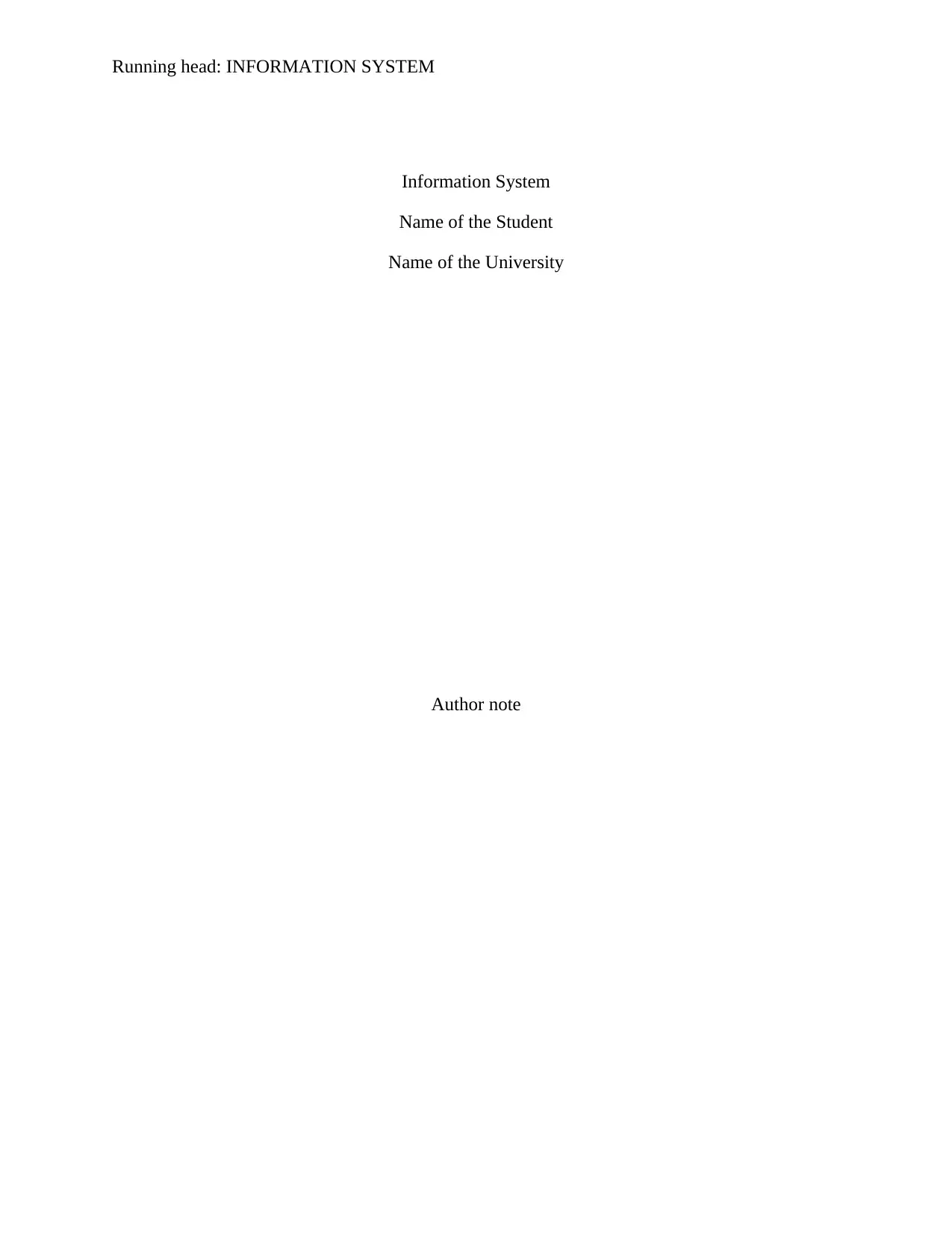
Running head: INFORMATION SYSTEM
Information System
Name of the Student
Name of the University
Author note
Information System
Name of the Student
Name of the University
Author note
Paraphrase This Document
Need a fresh take? Get an instant paraphrase of this document with our AI Paraphraser
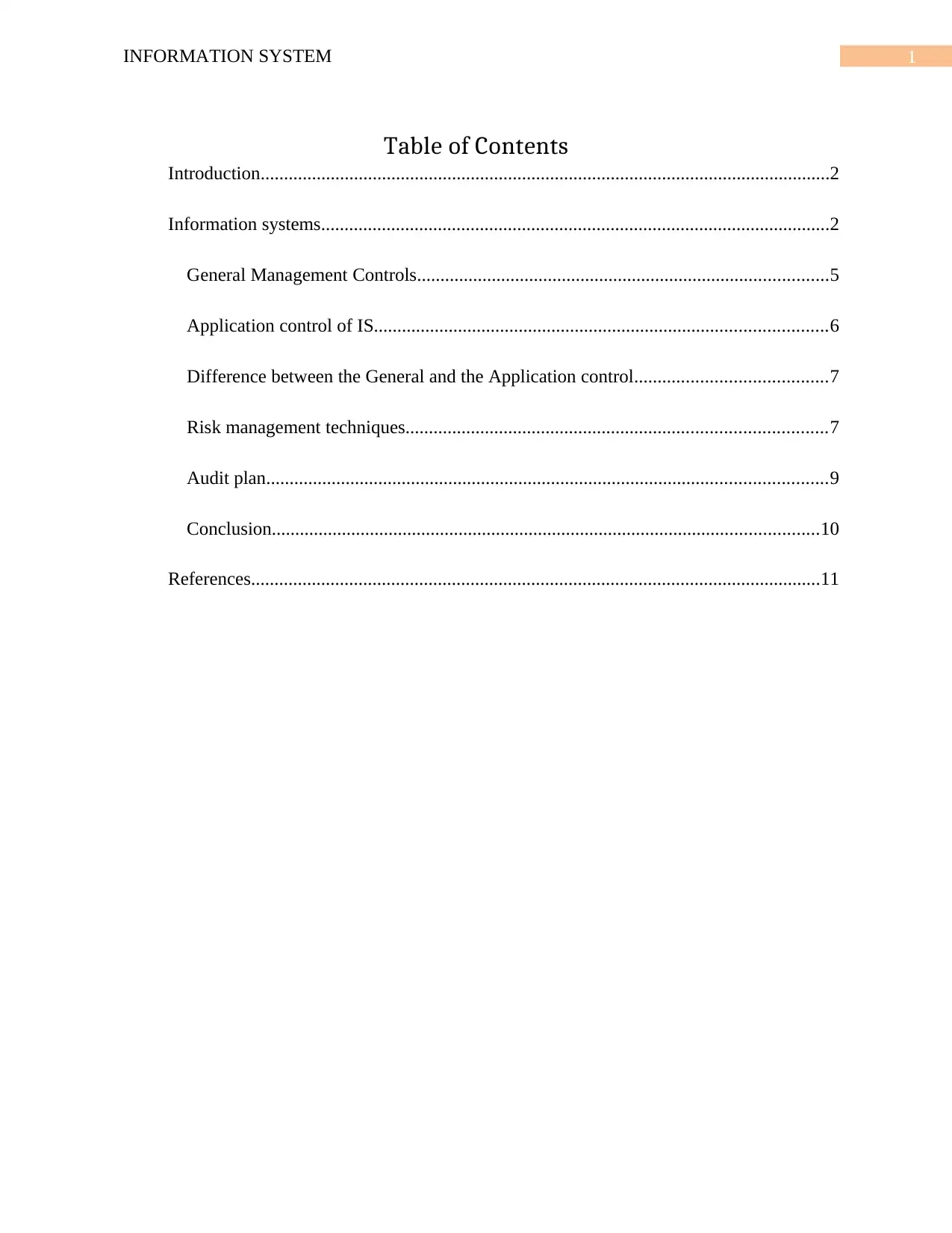
1INFORMATION SYSTEM
Table of Contents
Introduction..........................................................................................................................2
Information systems.............................................................................................................2
General Management Controls........................................................................................5
Application control of IS.................................................................................................6
Difference between the General and the Application control.........................................7
Risk management techniques..........................................................................................7
Audit plan........................................................................................................................9
Conclusion.....................................................................................................................10
References..........................................................................................................................11
Table of Contents
Introduction..........................................................................................................................2
Information systems.............................................................................................................2
General Management Controls........................................................................................5
Application control of IS.................................................................................................6
Difference between the General and the Application control.........................................7
Risk management techniques..........................................................................................7
Audit plan........................................................................................................................9
Conclusion.....................................................................................................................10
References..........................................................................................................................11
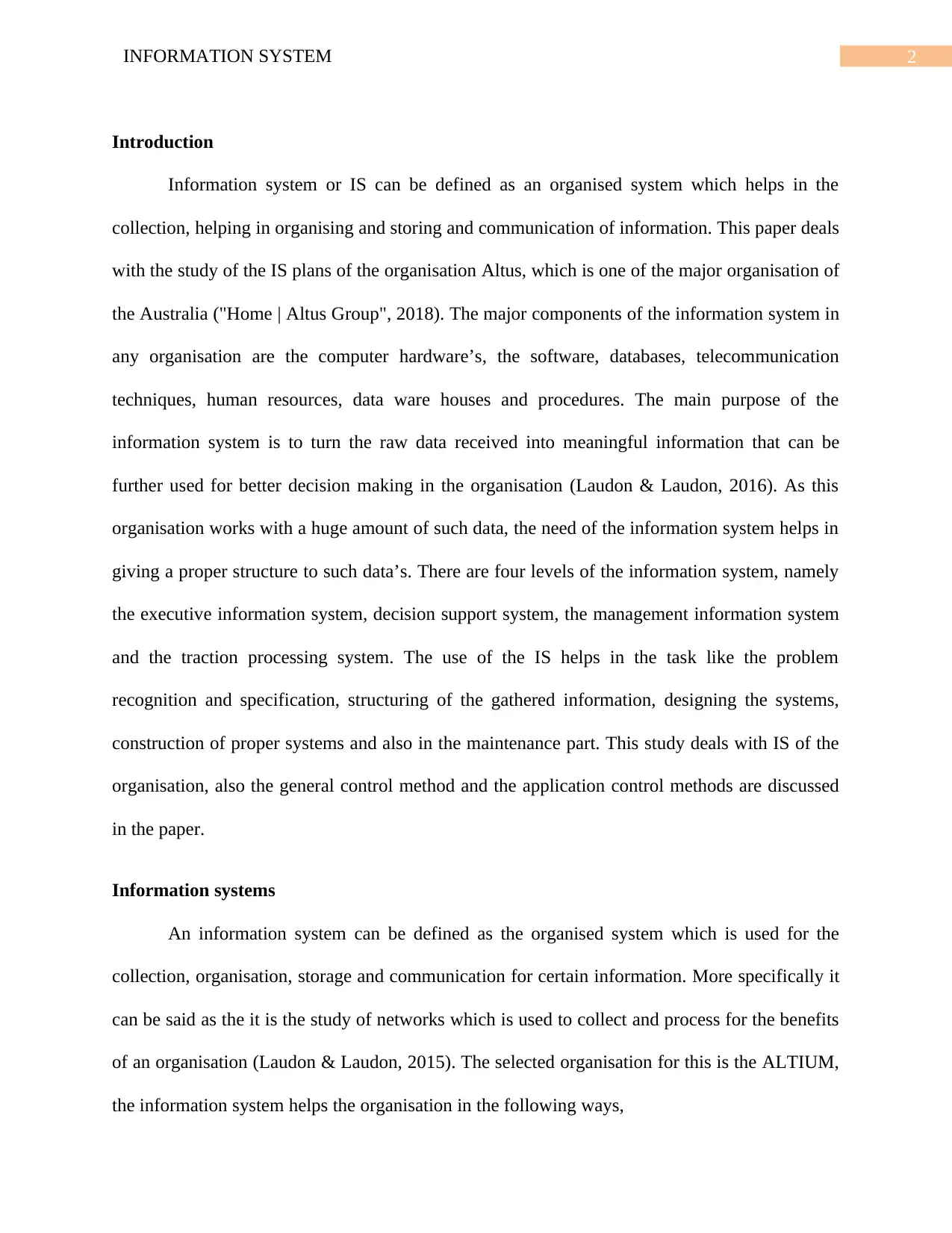
2INFORMATION SYSTEM
Introduction
Information system or IS can be defined as an organised system which helps in the
collection, helping in organising and storing and communication of information. This paper deals
with the study of the IS plans of the organisation Altus, which is one of the major organisation of
the Australia ("Home | Altus Group", 2018). The major components of the information system in
any organisation are the computer hardware’s, the software, databases, telecommunication
techniques, human resources, data ware houses and procedures. The main purpose of the
information system is to turn the raw data received into meaningful information that can be
further used for better decision making in the organisation (Laudon & Laudon, 2016). As this
organisation works with a huge amount of such data, the need of the information system helps in
giving a proper structure to such data’s. There are four levels of the information system, namely
the executive information system, decision support system, the management information system
and the traction processing system. The use of the IS helps in the task like the problem
recognition and specification, structuring of the gathered information, designing the systems,
construction of proper systems and also in the maintenance part. This study deals with IS of the
organisation, also the general control method and the application control methods are discussed
in the paper.
Information systems
An information system can be defined as the organised system which is used for the
collection, organisation, storage and communication for certain information. More specifically it
can be said as the it is the study of networks which is used to collect and process for the benefits
of an organisation (Laudon & Laudon, 2015). The selected organisation for this is the ALTIUM,
the information system helps the organisation in the following ways,
Introduction
Information system or IS can be defined as an organised system which helps in the
collection, helping in organising and storing and communication of information. This paper deals
with the study of the IS plans of the organisation Altus, which is one of the major organisation of
the Australia ("Home | Altus Group", 2018). The major components of the information system in
any organisation are the computer hardware’s, the software, databases, telecommunication
techniques, human resources, data ware houses and procedures. The main purpose of the
information system is to turn the raw data received into meaningful information that can be
further used for better decision making in the organisation (Laudon & Laudon, 2016). As this
organisation works with a huge amount of such data, the need of the information system helps in
giving a proper structure to such data’s. There are four levels of the information system, namely
the executive information system, decision support system, the management information system
and the traction processing system. The use of the IS helps in the task like the problem
recognition and specification, structuring of the gathered information, designing the systems,
construction of proper systems and also in the maintenance part. This study deals with IS of the
organisation, also the general control method and the application control methods are discussed
in the paper.
Information systems
An information system can be defined as the organised system which is used for the
collection, organisation, storage and communication for certain information. More specifically it
can be said as the it is the study of networks which is used to collect and process for the benefits
of an organisation (Laudon & Laudon, 2015). The selected organisation for this is the ALTIUM,
the information system helps the organisation in the following ways,
⊘ This is a preview!⊘
Do you want full access?
Subscribe today to unlock all pages.

Trusted by 1+ million students worldwide
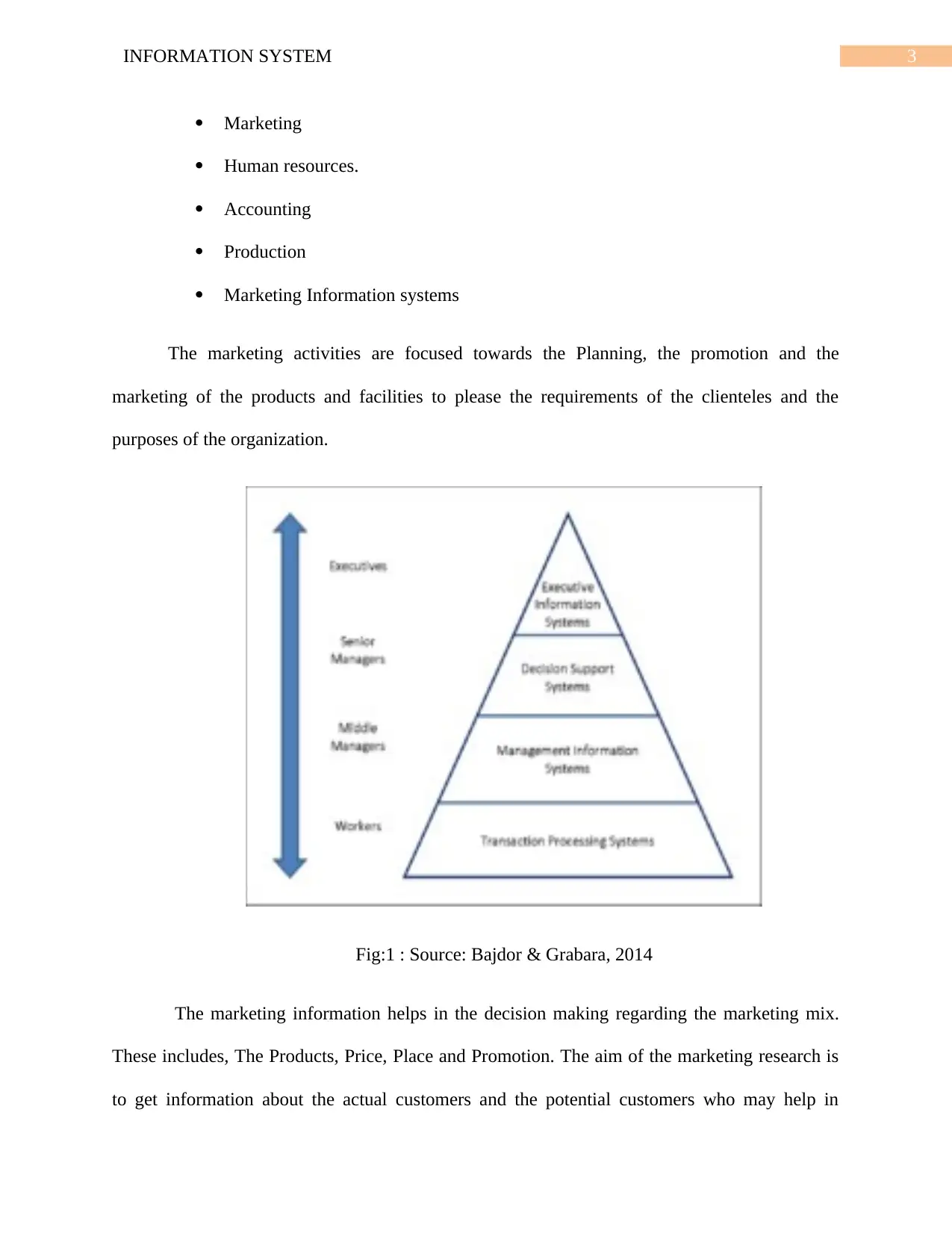
3INFORMATION SYSTEM
Marketing
Human resources.
Accounting
Production
Marketing Information systems
The marketing activities are focused towards the Planning, the promotion and the
marketing of the products and facilities to please the requirements of the clienteles and the
purposes of the organization.
Fig:1 : Source: Bajdor & Grabara, 2014
The marketing information helps in the decision making regarding the marketing mix.
These includes, The Products, Price, Place and Promotion. The aim of the marketing research is
to get information about the actual customers and the potential customers who may help in
Marketing
Human resources.
Accounting
Production
Marketing Information systems
The marketing activities are focused towards the Planning, the promotion and the
marketing of the products and facilities to please the requirements of the clienteles and the
purposes of the organization.
Fig:1 : Source: Bajdor & Grabara, 2014
The marketing information helps in the decision making regarding the marketing mix.
These includes, The Products, Price, Place and Promotion. The aim of the marketing research is
to get information about the actual customers and the potential customers who may help in
Paraphrase This Document
Need a fresh take? Get an instant paraphrase of this document with our AI Paraphraser
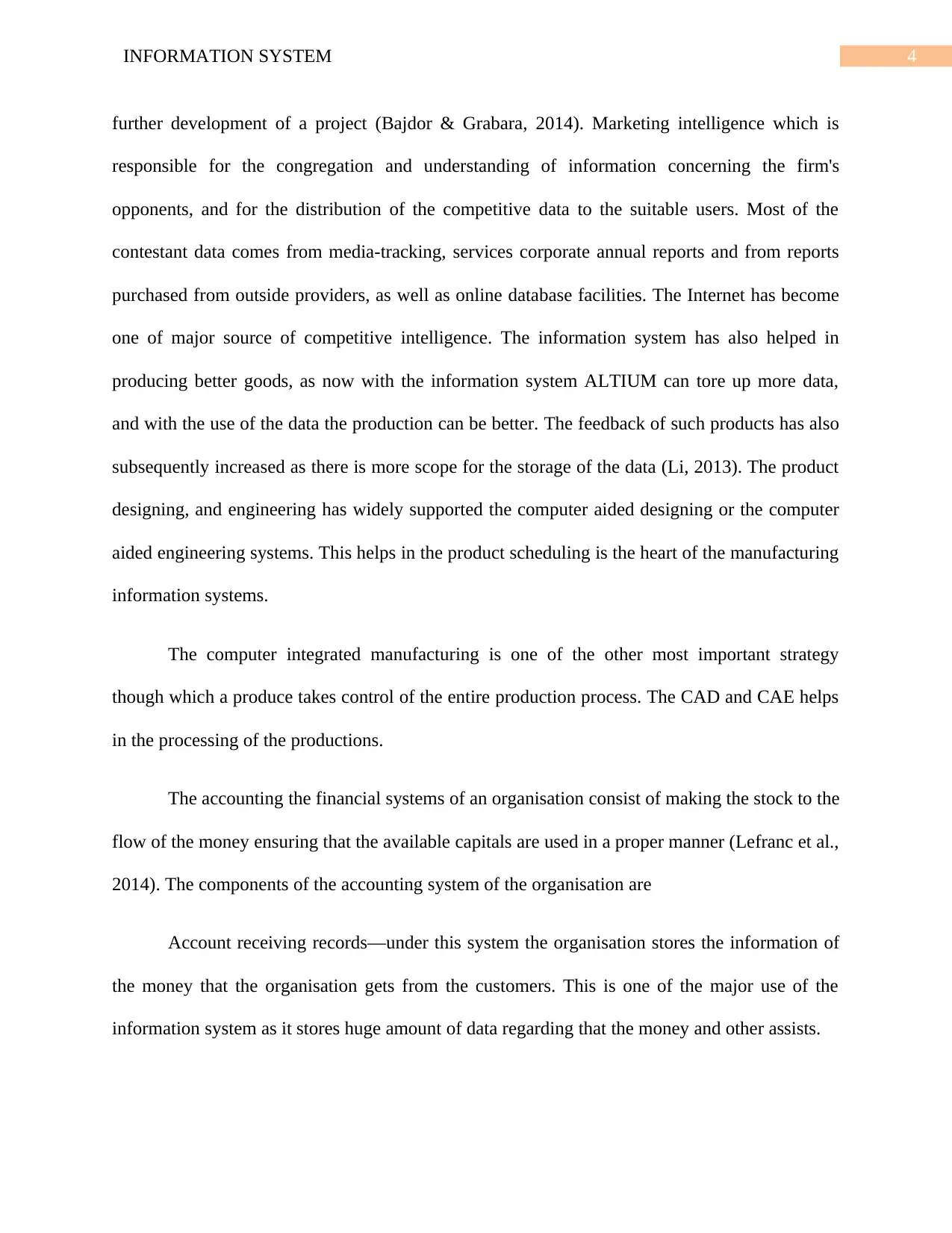
4INFORMATION SYSTEM
further development of a project (Bajdor & Grabara, 2014). Marketing intelligence which is
responsible for the congregation and understanding of information concerning the firm's
opponents, and for the distribution of the competitive data to the suitable users. Most of the
contestant data comes from media-tracking, services corporate annual reports and from reports
purchased from outside providers, as well as online database facilities. The Internet has become
one of major source of competitive intelligence. The information system has also helped in
producing better goods, as now with the information system ALTIUM can tore up more data,
and with the use of the data the production can be better. The feedback of such products has also
subsequently increased as there is more scope for the storage of the data (Li, 2013). The product
designing, and engineering has widely supported the computer aided designing or the computer
aided engineering systems. This helps in the product scheduling is the heart of the manufacturing
information systems.
The computer integrated manufacturing is one of the other most important strategy
though which a produce takes control of the entire production process. The CAD and CAE helps
in the processing of the productions.
The accounting the financial systems of an organisation consist of making the stock to the
flow of the money ensuring that the available capitals are used in a proper manner (Lefranc et al.,
2014). The components of the accounting system of the organisation are
Account receiving records—under this system the organisation stores the information of
the money that the organisation gets from the customers. This is one of the major use of the
information system as it stores huge amount of data regarding that the money and other assists.
further development of a project (Bajdor & Grabara, 2014). Marketing intelligence which is
responsible for the congregation and understanding of information concerning the firm's
opponents, and for the distribution of the competitive data to the suitable users. Most of the
contestant data comes from media-tracking, services corporate annual reports and from reports
purchased from outside providers, as well as online database facilities. The Internet has become
one of major source of competitive intelligence. The information system has also helped in
producing better goods, as now with the information system ALTIUM can tore up more data,
and with the use of the data the production can be better. The feedback of such products has also
subsequently increased as there is more scope for the storage of the data (Li, 2013). The product
designing, and engineering has widely supported the computer aided designing or the computer
aided engineering systems. This helps in the product scheduling is the heart of the manufacturing
information systems.
The computer integrated manufacturing is one of the other most important strategy
though which a produce takes control of the entire production process. The CAD and CAE helps
in the processing of the productions.
The accounting the financial systems of an organisation consist of making the stock to the
flow of the money ensuring that the available capitals are used in a proper manner (Lefranc et al.,
2014). The components of the accounting system of the organisation are
Account receiving records—under this system the organisation stores the information of
the money that the organisation gets from the customers. This is one of the major use of the
information system as it stores huge amount of data regarding that the money and other assists.
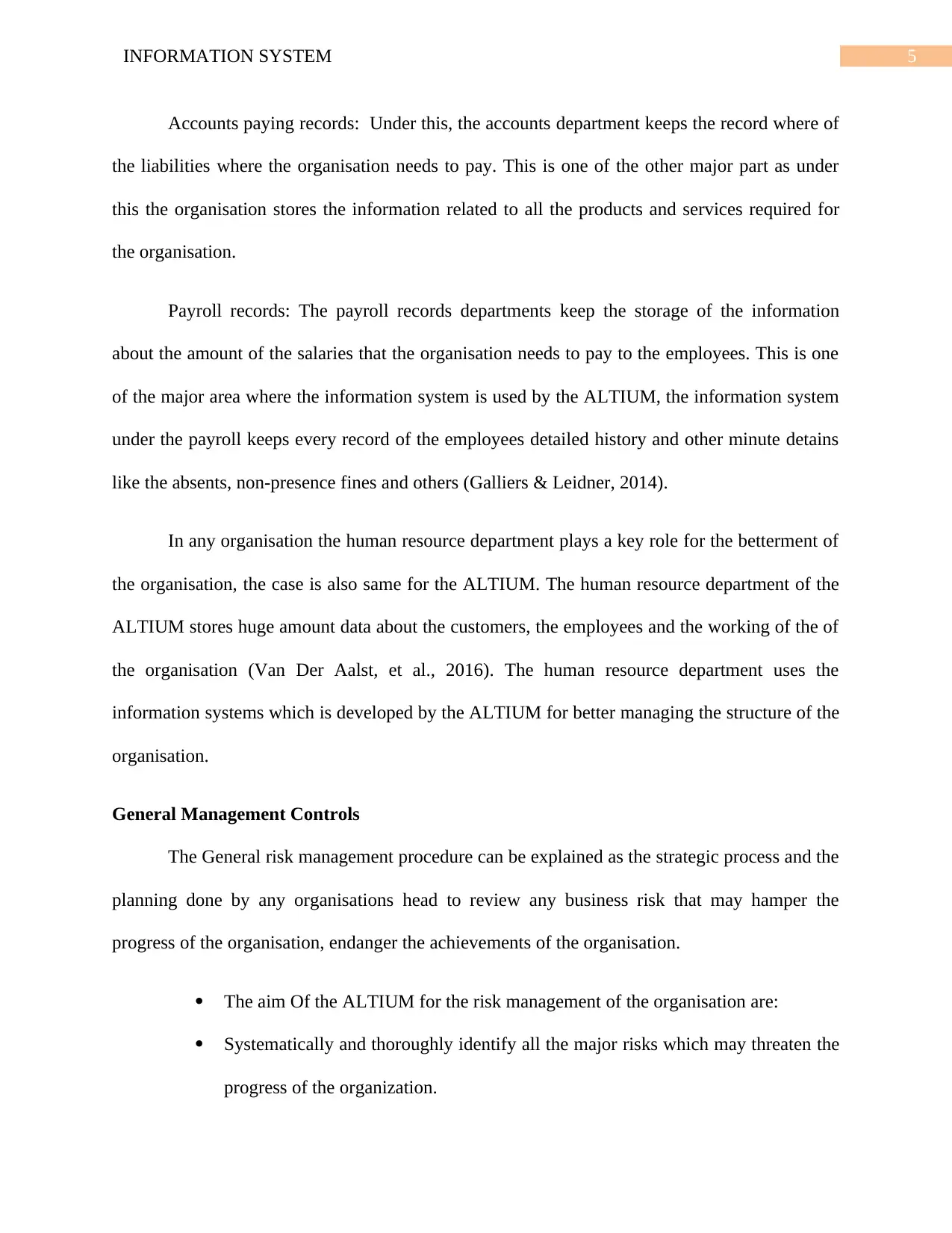
5INFORMATION SYSTEM
Accounts paying records: Under this, the accounts department keeps the record where of
the liabilities where the organisation needs to pay. This is one of the other major part as under
this the organisation stores the information related to all the products and services required for
the organisation.
Payroll records: The payroll records departments keep the storage of the information
about the amount of the salaries that the organisation needs to pay to the employees. This is one
of the major area where the information system is used by the ALTIUM, the information system
under the payroll keeps every record of the employees detailed history and other minute detains
like the absents, non-presence fines and others (Galliers & Leidner, 2014).
In any organisation the human resource department plays a key role for the betterment of
the organisation, the case is also same for the ALTIUM. The human resource department of the
ALTIUM stores huge amount data about the customers, the employees and the working of the of
the organisation (Van Der Aalst, et al., 2016). The human resource department uses the
information systems which is developed by the ALTIUM for better managing the structure of the
organisation.
General Management Controls
The General risk management procedure can be explained as the strategic process and the
planning done by any organisations head to review any business risk that may hamper the
progress of the organisation, endanger the achievements of the organisation.
The aim Of the ALTIUM for the risk management of the organisation are:
Systematically and thoroughly identify all the major risks which may threaten the
progress of the organization.
Accounts paying records: Under this, the accounts department keeps the record where of
the liabilities where the organisation needs to pay. This is one of the other major part as under
this the organisation stores the information related to all the products and services required for
the organisation.
Payroll records: The payroll records departments keep the storage of the information
about the amount of the salaries that the organisation needs to pay to the employees. This is one
of the major area where the information system is used by the ALTIUM, the information system
under the payroll keeps every record of the employees detailed history and other minute detains
like the absents, non-presence fines and others (Galliers & Leidner, 2014).
In any organisation the human resource department plays a key role for the betterment of
the organisation, the case is also same for the ALTIUM. The human resource department of the
ALTIUM stores huge amount data about the customers, the employees and the working of the of
the organisation (Van Der Aalst, et al., 2016). The human resource department uses the
information systems which is developed by the ALTIUM for better managing the structure of the
organisation.
General Management Controls
The General risk management procedure can be explained as the strategic process and the
planning done by any organisations head to review any business risk that may hamper the
progress of the organisation, endanger the achievements of the organisation.
The aim Of the ALTIUM for the risk management of the organisation are:
Systematically and thoroughly identify all the major risks which may threaten the
progress of the organization.
⊘ This is a preview!⊘
Do you want full access?
Subscribe today to unlock all pages.

Trusted by 1+ million students worldwide
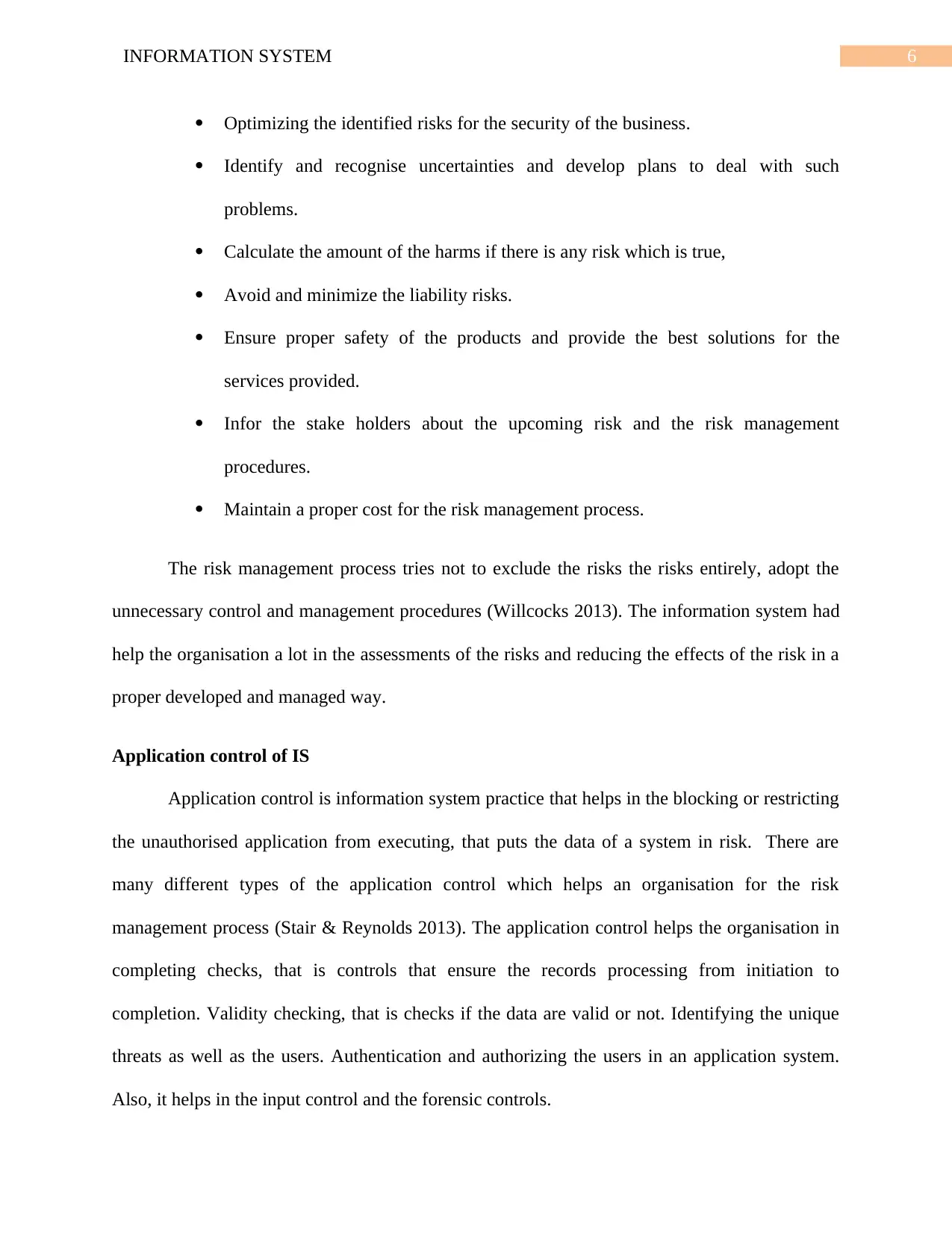
6INFORMATION SYSTEM
Optimizing the identified risks for the security of the business.
Identify and recognise uncertainties and develop plans to deal with such
problems.
Calculate the amount of the harms if there is any risk which is true,
Avoid and minimize the liability risks.
Ensure proper safety of the products and provide the best solutions for the
services provided.
Infor the stake holders about the upcoming risk and the risk management
procedures.
Maintain a proper cost for the risk management process.
The risk management process tries not to exclude the risks the risks entirely, adopt the
unnecessary control and management procedures (Willcocks 2013). The information system had
help the organisation a lot in the assessments of the risks and reducing the effects of the risk in a
proper developed and managed way.
Application control of IS
Application control is information system practice that helps in the blocking or restricting
the unauthorised application from executing, that puts the data of a system in risk. There are
many different types of the application control which helps an organisation for the risk
management process (Stair & Reynolds 2013). The application control helps the organisation in
completing checks, that is controls that ensure the records processing from initiation to
completion. Validity checking, that is checks if the data are valid or not. Identifying the unique
threats as well as the users. Authentication and authorizing the users in an application system.
Also, it helps in the input control and the forensic controls.
Optimizing the identified risks for the security of the business.
Identify and recognise uncertainties and develop plans to deal with such
problems.
Calculate the amount of the harms if there is any risk which is true,
Avoid and minimize the liability risks.
Ensure proper safety of the products and provide the best solutions for the
services provided.
Infor the stake holders about the upcoming risk and the risk management
procedures.
Maintain a proper cost for the risk management process.
The risk management process tries not to exclude the risks the risks entirely, adopt the
unnecessary control and management procedures (Willcocks 2013). The information system had
help the organisation a lot in the assessments of the risks and reducing the effects of the risk in a
proper developed and managed way.
Application control of IS
Application control is information system practice that helps in the blocking or restricting
the unauthorised application from executing, that puts the data of a system in risk. There are
many different types of the application control which helps an organisation for the risk
management process (Stair & Reynolds 2013). The application control helps the organisation in
completing checks, that is controls that ensure the records processing from initiation to
completion. Validity checking, that is checks if the data are valid or not. Identifying the unique
threats as well as the users. Authentication and authorizing the users in an application system.
Also, it helps in the input control and the forensic controls.
Paraphrase This Document
Need a fresh take? Get an instant paraphrase of this document with our AI Paraphraser
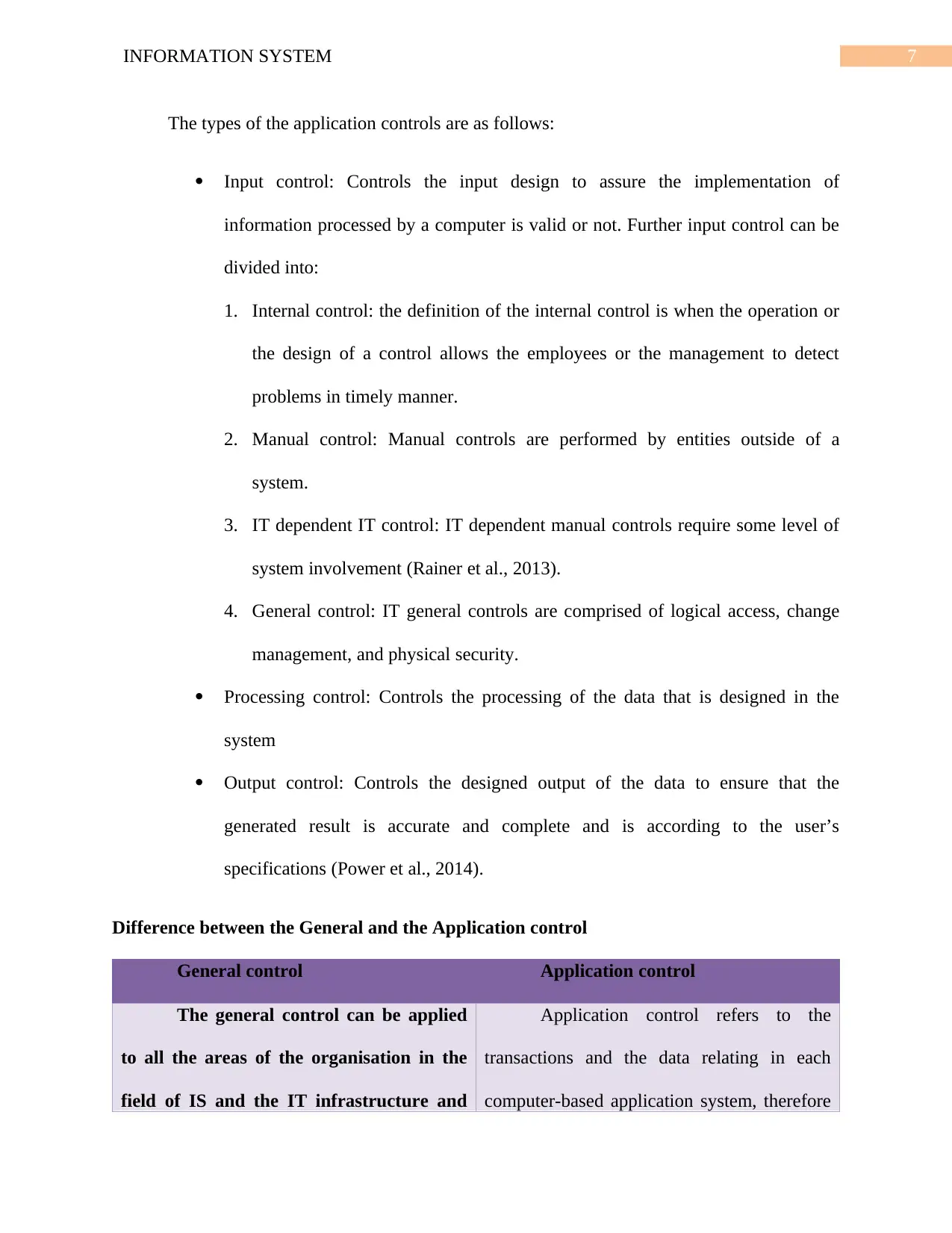
7INFORMATION SYSTEM
The types of the application controls are as follows:
Input control: Controls the input design to assure the implementation of
information processed by a computer is valid or not. Further input control can be
divided into:
1. Internal control: the definition of the internal control is when the operation or
the design of a control allows the employees or the management to detect
problems in timely manner.
2. Manual control: Manual controls are performed by entities outside of a
system.
3. IT dependent IT control: IT dependent manual controls require some level of
system involvement (Rainer et al., 2013).
4. General control: IT general controls are comprised of logical access, change
management, and physical security.
Processing control: Controls the processing of the data that is designed in the
system
Output control: Controls the designed output of the data to ensure that the
generated result is accurate and complete and is according to the user’s
specifications (Power et al., 2014).
Difference between the General and the Application control
General control Application control
The general control can be applied
to all the areas of the organisation in the
field of IS and the IT infrastructure and
Application control refers to the
transactions and the data relating in each
computer-based application system, therefore
The types of the application controls are as follows:
Input control: Controls the input design to assure the implementation of
information processed by a computer is valid or not. Further input control can be
divided into:
1. Internal control: the definition of the internal control is when the operation or
the design of a control allows the employees or the management to detect
problems in timely manner.
2. Manual control: Manual controls are performed by entities outside of a
system.
3. IT dependent IT control: IT dependent manual controls require some level of
system involvement (Rainer et al., 2013).
4. General control: IT general controls are comprised of logical access, change
management, and physical security.
Processing control: Controls the processing of the data that is designed in the
system
Output control: Controls the designed output of the data to ensure that the
generated result is accurate and complete and is according to the user’s
specifications (Power et al., 2014).
Difference between the General and the Application control
General control Application control
The general control can be applied
to all the areas of the organisation in the
field of IS and the IT infrastructure and
Application control refers to the
transactions and the data relating in each
computer-based application system, therefore
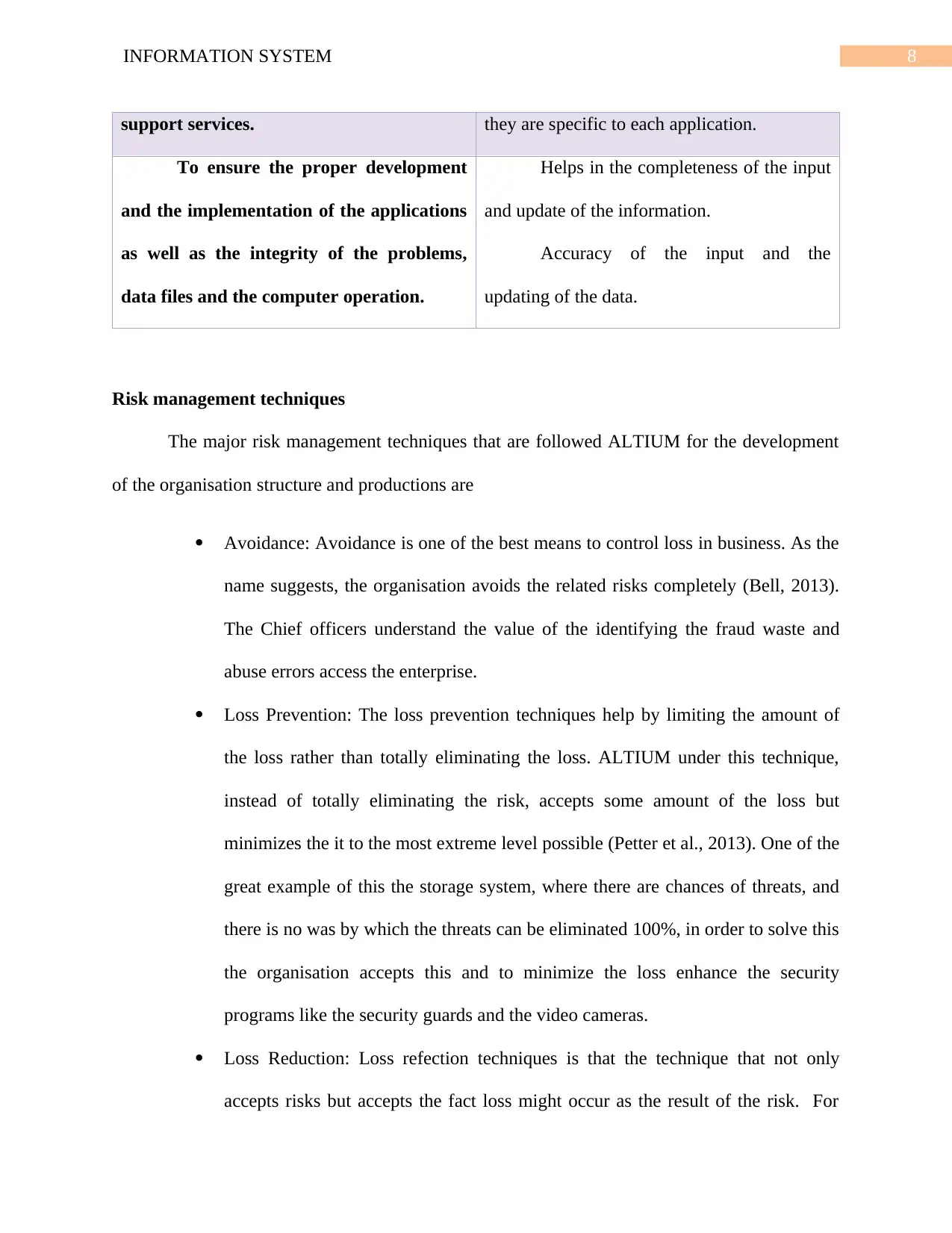
8INFORMATION SYSTEM
support services. they are specific to each application.
To ensure the proper development
and the implementation of the applications
as well as the integrity of the problems,
data files and the computer operation.
Helps in the completeness of the input
and update of the information.
Accuracy of the input and the
updating of the data.
Risk management techniques
The major risk management techniques that are followed ALTIUM for the development
of the organisation structure and productions are
Avoidance: Avoidance is one of the best means to control loss in business. As the
name suggests, the organisation avoids the related risks completely (Bell, 2013).
The Chief officers understand the value of the identifying the fraud waste and
abuse errors access the enterprise.
Loss Prevention: The loss prevention techniques help by limiting the amount of
the loss rather than totally eliminating the loss. ALTIUM under this technique,
instead of totally eliminating the risk, accepts some amount of the loss but
minimizes the it to the most extreme level possible (Petter et al., 2013). One of the
great example of this the storage system, where there are chances of threats, and
there is no was by which the threats can be eliminated 100%, in order to solve this
the organisation accepts this and to minimize the loss enhance the security
programs like the security guards and the video cameras.
Loss Reduction: Loss refection techniques is that the technique that not only
accepts risks but accepts the fact loss might occur as the result of the risk. For
support services. they are specific to each application.
To ensure the proper development
and the implementation of the applications
as well as the integrity of the problems,
data files and the computer operation.
Helps in the completeness of the input
and update of the information.
Accuracy of the input and the
updating of the data.
Risk management techniques
The major risk management techniques that are followed ALTIUM for the development
of the organisation structure and productions are
Avoidance: Avoidance is one of the best means to control loss in business. As the
name suggests, the organisation avoids the related risks completely (Bell, 2013).
The Chief officers understand the value of the identifying the fraud waste and
abuse errors access the enterprise.
Loss Prevention: The loss prevention techniques help by limiting the amount of
the loss rather than totally eliminating the loss. ALTIUM under this technique,
instead of totally eliminating the risk, accepts some amount of the loss but
minimizes the it to the most extreme level possible (Petter et al., 2013). One of the
great example of this the storage system, where there are chances of threats, and
there is no was by which the threats can be eliminated 100%, in order to solve this
the organisation accepts this and to minimize the loss enhance the security
programs like the security guards and the video cameras.
Loss Reduction: Loss refection techniques is that the technique that not only
accepts risks but accepts the fact loss might occur as the result of the risk. For
⊘ This is a preview!⊘
Do you want full access?
Subscribe today to unlock all pages.

Trusted by 1+ million students worldwide
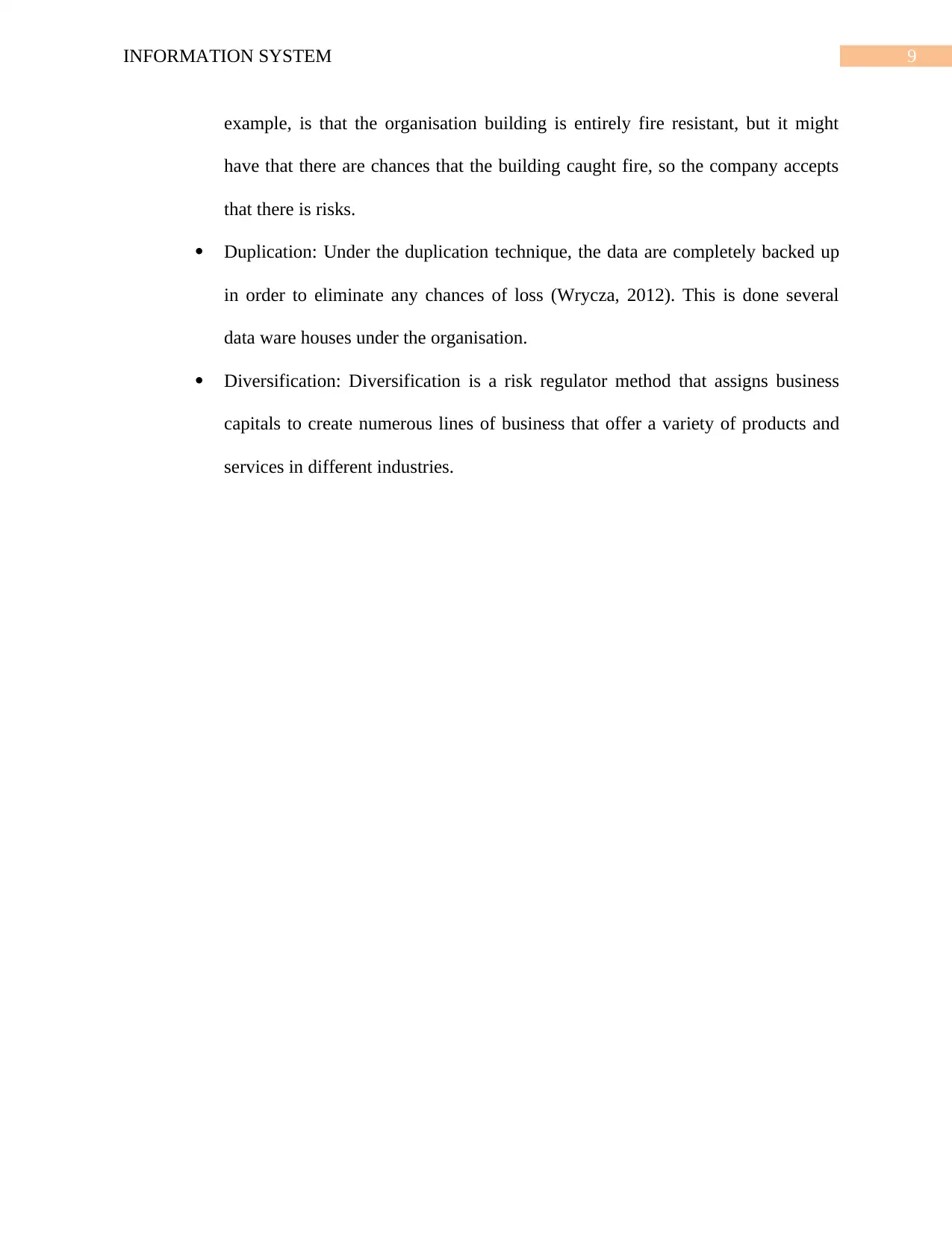
9INFORMATION SYSTEM
example, is that the organisation building is entirely fire resistant, but it might
have that there are chances that the building caught fire, so the company accepts
that there is risks.
Duplication: Under the duplication technique, the data are completely backed up
in order to eliminate any chances of loss (Wrycza, 2012). This is done several
data ware houses under the organisation.
Diversification: Diversification is a risk regulator method that assigns business
capitals to create numerous lines of business that offer a variety of products and
services in different industries.
example, is that the organisation building is entirely fire resistant, but it might
have that there are chances that the building caught fire, so the company accepts
that there is risks.
Duplication: Under the duplication technique, the data are completely backed up
in order to eliminate any chances of loss (Wrycza, 2012). This is done several
data ware houses under the organisation.
Diversification: Diversification is a risk regulator method that assigns business
capitals to create numerous lines of business that offer a variety of products and
services in different industries.
Paraphrase This Document
Need a fresh take? Get an instant paraphrase of this document with our AI Paraphraser
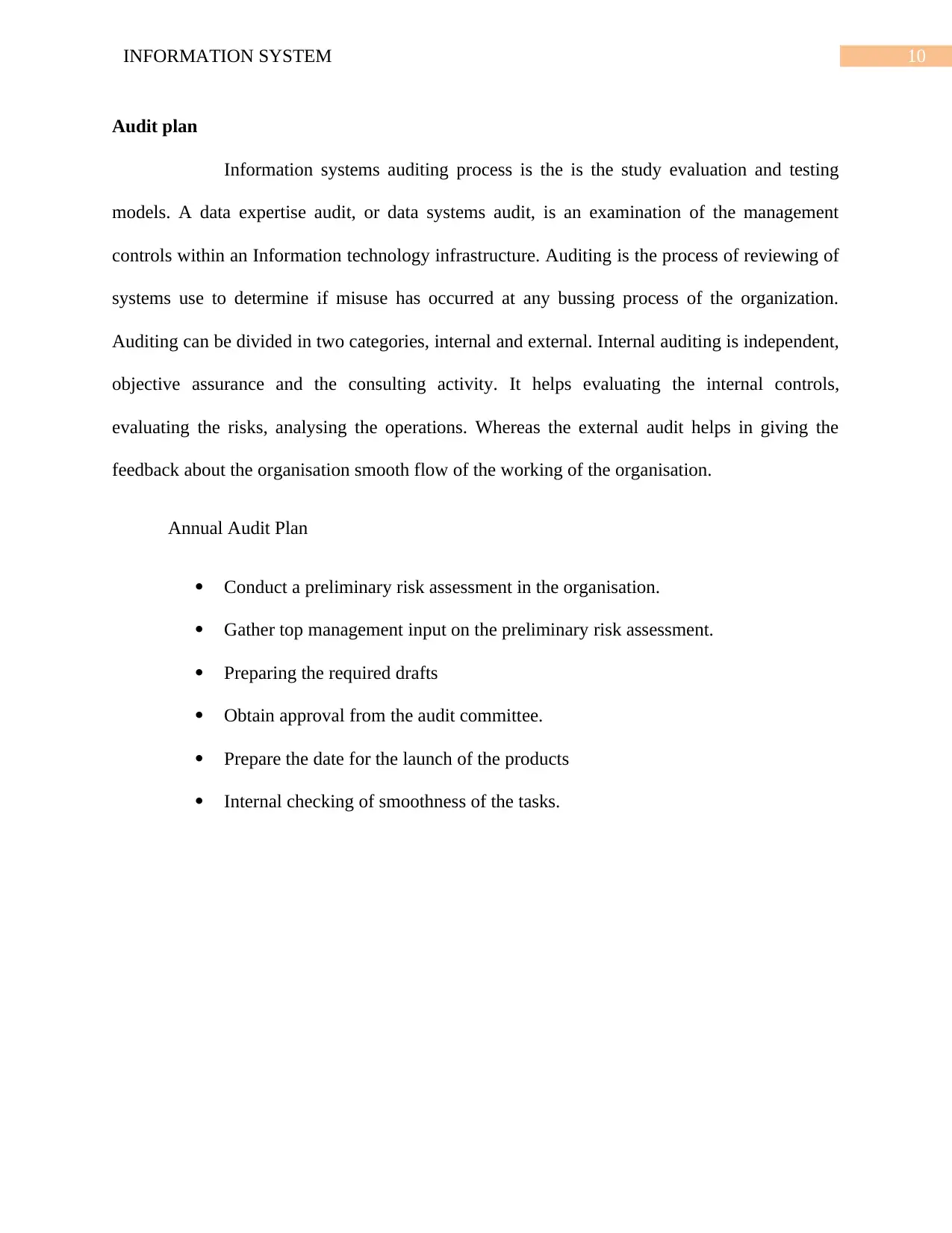
10INFORMATION SYSTEM
Audit plan
Information systems auditing process is the is the study evaluation and testing
models. A data expertise audit, or data systems audit, is an examination of the management
controls within an Information technology infrastructure. Auditing is the process of reviewing of
systems use to determine if misuse has occurred at any bussing process of the organization.
Auditing can be divided in two categories, internal and external. Internal auditing is independent,
objective assurance and the consulting activity. It helps evaluating the internal controls,
evaluating the risks, analysing the operations. Whereas the external audit helps in giving the
feedback about the organisation smooth flow of the working of the organisation.
Annual Audit Plan
Conduct a preliminary risk assessment in the organisation.
Gather top management input on the preliminary risk assessment.
Preparing the required drafts
Obtain approval from the audit committee.
Prepare the date for the launch of the products
Internal checking of smoothness of the tasks.
Audit plan
Information systems auditing process is the is the study evaluation and testing
models. A data expertise audit, or data systems audit, is an examination of the management
controls within an Information technology infrastructure. Auditing is the process of reviewing of
systems use to determine if misuse has occurred at any bussing process of the organization.
Auditing can be divided in two categories, internal and external. Internal auditing is independent,
objective assurance and the consulting activity. It helps evaluating the internal controls,
evaluating the risks, analysing the operations. Whereas the external audit helps in giving the
feedback about the organisation smooth flow of the working of the organisation.
Annual Audit Plan
Conduct a preliminary risk assessment in the organisation.
Gather top management input on the preliminary risk assessment.
Preparing the required drafts
Obtain approval from the audit committee.
Prepare the date for the launch of the products
Internal checking of smoothness of the tasks.
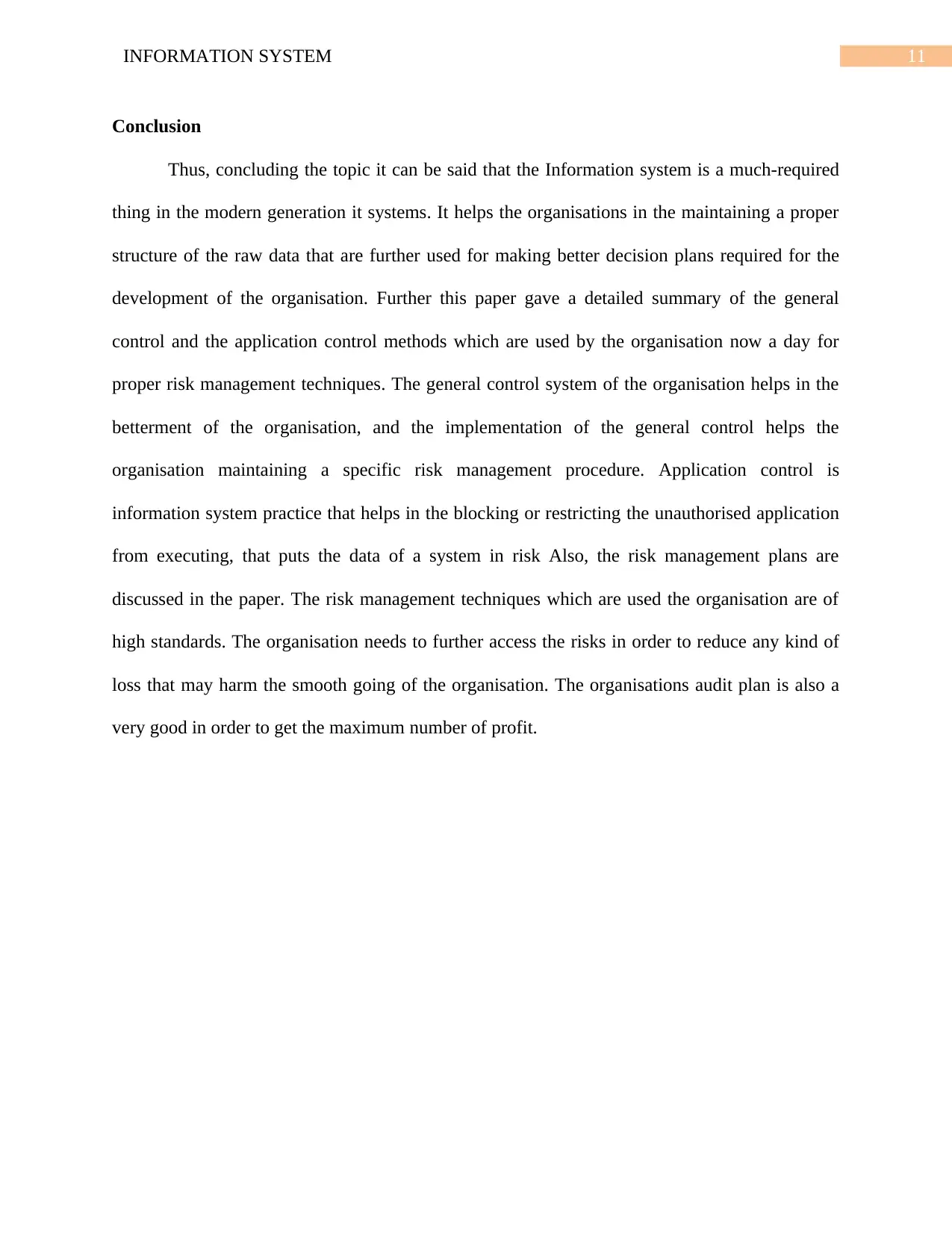
11INFORMATION SYSTEM
Conclusion
Thus, concluding the topic it can be said that the Information system is a much-required
thing in the modern generation it systems. It helps the organisations in the maintaining a proper
structure of the raw data that are further used for making better decision plans required for the
development of the organisation. Further this paper gave a detailed summary of the general
control and the application control methods which are used by the organisation now a day for
proper risk management techniques. The general control system of the organisation helps in the
betterment of the organisation, and the implementation of the general control helps the
organisation maintaining a specific risk management procedure. Application control is
information system practice that helps in the blocking or restricting the unauthorised application
from executing, that puts the data of a system in risk Also, the risk management plans are
discussed in the paper. The risk management techniques which are used the organisation are of
high standards. The organisation needs to further access the risks in order to reduce any kind of
loss that may harm the smooth going of the organisation. The organisations audit plan is also a
very good in order to get the maximum number of profit.
Conclusion
Thus, concluding the topic it can be said that the Information system is a much-required
thing in the modern generation it systems. It helps the organisations in the maintaining a proper
structure of the raw data that are further used for making better decision plans required for the
development of the organisation. Further this paper gave a detailed summary of the general
control and the application control methods which are used by the organisation now a day for
proper risk management techniques. The general control system of the organisation helps in the
betterment of the organisation, and the implementation of the general control helps the
organisation maintaining a specific risk management procedure. Application control is
information system practice that helps in the blocking or restricting the unauthorised application
from executing, that puts the data of a system in risk Also, the risk management plans are
discussed in the paper. The risk management techniques which are used the organisation are of
high standards. The organisation needs to further access the risks in order to reduce any kind of
loss that may harm the smooth going of the organisation. The organisations audit plan is also a
very good in order to get the maximum number of profit.
⊘ This is a preview!⊘
Do you want full access?
Subscribe today to unlock all pages.

Trusted by 1+ million students worldwide
1 out of 15
Related Documents
Your All-in-One AI-Powered Toolkit for Academic Success.
+13062052269
info@desklib.com
Available 24*7 on WhatsApp / Email
![[object Object]](/_next/static/media/star-bottom.7253800d.svg)
Unlock your academic potential
Copyright © 2020–2025 A2Z Services. All Rights Reserved. Developed and managed by ZUCOL.

